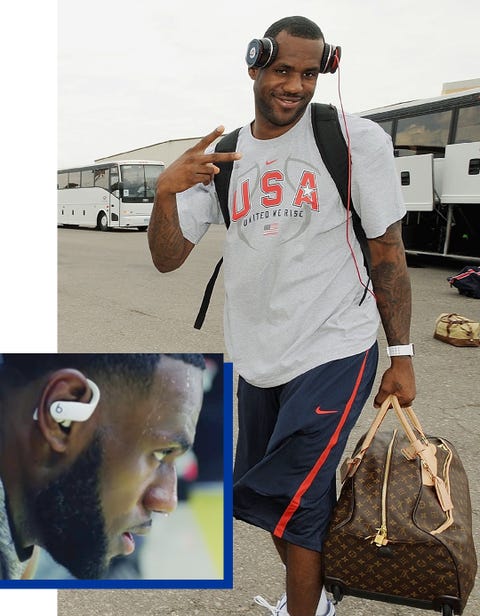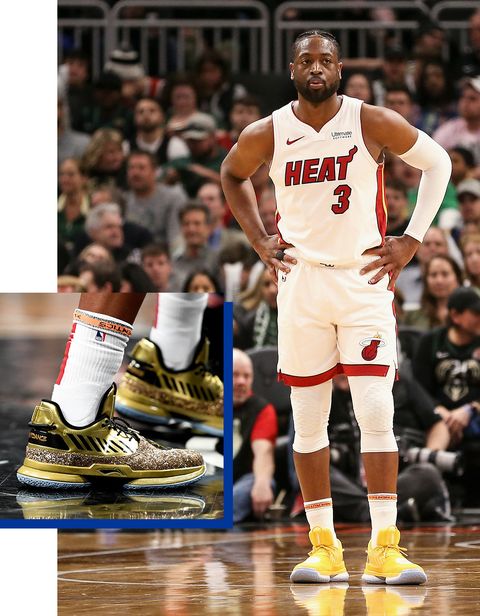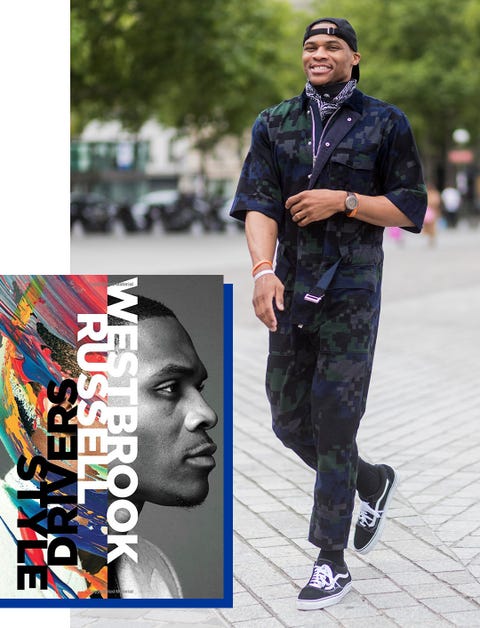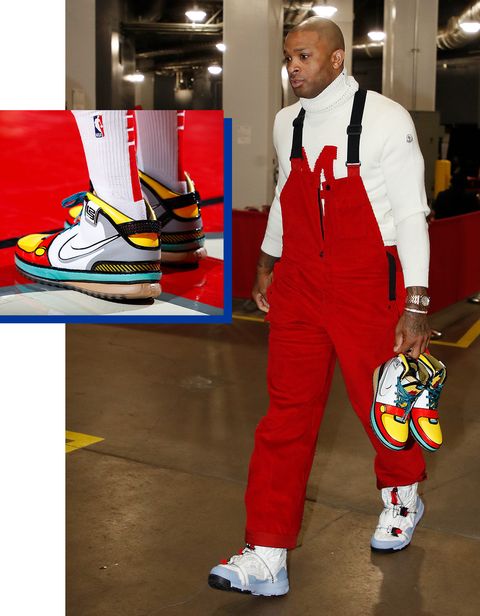Why the NBA and the Fashion Industry Are Connected – NBA Fashion Style Concrete Runway Outfit – Esquire
LeBron James and a pair of headphones changed the NBA’s relationship with fashion forever. It was 2008, and the U.S. men’s Olympic basketball team had just touched down in Shanghai. The upstart tech brand had barely launched, selling its first pair of headphones to Best Buy just two months earlier. They were positioned as music-industry-only. That is, until LeBron James walked off the plane in China wearing them. Beats by Dre went mainstream practically overnight.
“We really thought nothing of [gifting James and the team headphones] because we were completely focused on music at the time,” says Beats president, Luke Wood. But athletes, specifically basketball players, turned out to be a market profitable beyond measure. Wood says it’s difficult to quantify the impact James’s tacit endorsement had on sales, but anecdotally? Beats became Beats because of LeBron James.
Before Beats and LeBron, basketball players were expected to function inside a limited space. Be a player. Be a role model. Endorse a sneaker or a cereal. They might have influence in the performance space by working with apparel brands like Nike or Adidas, or sports-adjacent brands like Gatorade. But Beats’ success was a moment of realization: Fans don’t just care about LeBron James the basketball player. They care about LeBron James the man. Lebron James the brand. Whether it’s Beats headphones, a Thom Browne suit, or John Elliott sneakers, fans want to know what LeBron James is wearing, and they want to wear it, too.

Beats by Dre, Getty Images
This attitude—players as legitimate fashion influencers—has infiltrated the sport at large, especially in particularly marketable moments, like when the athletes are walking off a plane or through an arena’s tunnel, now often referred to as the “concrete runway.” Athletes are using that exposure to build something for themselves: They’re wearing new kinds of headphones, runway-only fashion items, and not-yet-launched pieces of streetwear. In today’s NBA, the athletes are their own brands. What they’re wearing is not just personal style. It’s a business.
Outfits Aren’t Just Outfits—They’re Money
Small beginnings—outfit choices, really—can lead to large-scale deals. Beats now has an official collaboration with the NBA. Russell Westbrook took his over-the-top outfits from the concrete runway to his Instagram page to a book, Style Drivers. Dwyane Wade collaborated with Stance socks and launched his own sock company in partnership with the brand. Now, Stance is the NBA’s official on-court sock.
“We’re seeing athletes driving more and more value for the brands they work with,” says Roger Breum, the marketing director at Hookit, a sports partnerships analytics and evaluation firm. “Over the past few years, the individual athlete has become the most powerful part of sports. We don’t expect that to change anytime soon.”

Getty Images
In 2018, LeBron James drove $137 million in revenue for his sponsors, and Stephen Curry drove $39 million, according to Hookit. Although that number is for all brands, Hookit says apparel makes up “a large chunk” of the total.
Of course, apparel partnerships with the players and the league have long existed, but they’ve largely been limited to the sportswear giants like Nike and Adidas. Some large-scale sponsorships have even created legitimate powerhouse brands—just look to Air Jordan—but the phenomenon of players bringing quantifiable business value to fashion and accessories brands that started off the court is a new one.
“Athletes have really developed a love of fashion,” says NBA’s senior vice president of merchandising partnerships, Lisa Piken Koper. “They’re sitting front row at fashion shows, working on their own collaborations outside of basketball. The walk into the arena has now become their runway.”
The Rise of a Platform
Basketball’s fashion fandom isn’t exactly new. Walt “Clyde” Frazier, Wilt Chamberlain, and Magic Johnson all cared about what they wore. In fact, Magic Johnson told Esquire that the new guys shouldn’t be getting all the credit for their fashion sense: “We all wore what was hot in our day, too. The difference [today] is the players get to show people right then and there what they have. Unless you came and took a picture of me, no one would’ve known what I wore.”
The interest was there. It was the platform that was missing. So what changed? Two things, really: a monumental rule change and the advent of social media.
In 2005, NBA commissioner David Stern passed a rule that required business casual dress for team- and game-related events, including that walk into the arena. Although purposely vague, it meant players had to wear suits or dress pants and collared shirts. The more controversial part of the rule was not what it enforced but what it banned: chains, pendants, and medallions.

Courtesy, Getty Images
SHOP Russell Westbrook’s ‘Style Drivers’ $37.40, amazon.com
Critics decried the new regulation as racist, connecting the specific chains and medallions to the style Allen Iverson is credited with bringing to the league—and the racially coded PR troubles and accusations of “unruliness” that followed. But once the dress code went into effect, it brought with it a newfound focus on style.
“The players took this rule, which was made as a form of control, and made it into something that became an avenue to drive style and culture,” says Beats’ president Luke Wood. “Style is this gateway for them to really start thinking about who they are outside of basketball.”
Social Media Takes Things Into the Stratosphere
Most basketball players, upon entering the league, have grown up with a single goal in mind: Make it to the NBA. But once they’ve made it, they have more mental energy (and resources) to spend developing themselves off the court. To make a name for themselves that’ll last, players need to become a brand.
“I think the theory of the dress code bringing more awareness to players’ fashion, along with the introduction of social media and the ability to brand yourself really helped [blow fashion up].” says Koper. “Our guys take really fun fashion risks. They’ve created an anticipation of what they’ll be wearing.”
Most of that anticipation is built on social media. Maybe Magic Johnson didn’t have any place to showcase his outfits, but today there’s Instagram, where players can post and control the content themselves. Like Johnson said: No one knows what you wore if there was no one to take a photo of it.
UpscaleHype, a website dedicated to posting photos of celebrities’ high-fashion and streetwear-heavy outfits, pushes the photos of those outfits into the open. “I think the most important thing is exposure,” says Allen Onyia, the site’s co-founder. “You can do as much as you want, wear any crazy look you want, but if no one is seeing it then it has no value. You need to work with platforms that expose it.”
UpscaleHype has been around since 2008, but the influx of other basketball style-related Instagram pages and media coverage has brought even more attention to the players’ outfits. “We’ve been tracking celebrity style for a while, and basketball has always been a part of it for us,” says Onyia. “But now, we’re starting to see it pick up other places, like the NBA creating Instagram pages, more sneaker pages existing, more NBA-related style pages. It feels like the fashion community is starting to respect the style of athletes more and more.”
Now that there’s a place to build fan anticipation, players are capitalizing on it. Instead of just meeting the league-dictated “business casual” requirement, players work with stylists, designers, and brands to craft the looks they wear down the concrete runway. It’s not just an outfit. It’s business—and it’s highly strategic.

.
The clothes players are wearing are often decided weeks or months in advance, says celebrity stylist and visual architect Kesha McLeod. Although right now, the planning can be a little hodgepodge, McLeod—who styles the likes of James Harden, P.J. Tucker, and Serena Williams—sees it becoming more streamlined soon.
“We’re starting to bring the athletes in on all of our meetings,” she says. “We’re helping each other from the start. Now, the meeting will be with, say, Valentino, James [Harden], his manager, and me. We decide what his brand is going to be for this season and we start telling the story. It’s not an afterthought.”
And when it comes to the first game of the season, “You have to have the perfect outfit” says McLeod, “because that’s what you’re setting the tone with for the rest of the season.”
The postseason holds, potentially, even more power. “Especially getting into the playoffs, if someone makes a statement at postgame press conference, it gets picked up,” says the NBA’s Koper. “You want to be ready for it.”
Non-Performance Brands Have Room to Compete
In 2008, when James wore Beats headphones off the plane to the Olympics, it changed Beats. This moment, seeing an athlete wearing something initially marketed to a different industry, shifted how brands used players as marketing tools: Get your clothes and lifestyle goods in the hands of athletes and their stylists, and attention will follow. Beyond the brand exposure, it really represents an opportunity for brands much smaller than a Nike or an Adidas to flourish.

Getty Images
Take Filling Pieces, for example, an Amsterdam-based clothing company. The brand started with mid-range sneakers—to “fill” the gap between high fashion and streetwear, hence the name—but sneakers are a tough space for athletes, many of whom have partnerships with bigger brands and are contractually obligated to only be seen wearing that brand sneaker. Still, Filling Pieces wanted to find a way in.
“We expanded into ready to wear, instead of just sneakers,” says Chris Alders, Filling Pieces’ marketing manager. “This gave us an opportunity to work with athletes when they can choose their own styles outside of their contracts.”
It worked. In March 2018, Houston Rockets guard Chris Paul was photographed hopping off the plane in a full bright blue Filling Pieces tracksuit. Orders for that suit in that color quadrupled for the brand over the next two weeks. The day Chris Paul’s Instagram post went live, Filling Pieces saw a 104 percent increase of U.S. traffic to the website, which tapered off over the next few days. In March, now-retired Miami Heat guard Dwyane Wade wore a Filling Pieces jacket in a post-game interview; the brand saw a 89 percent increase of U.S. traffic to the site.
Then there’s Stance socks. Soon after launching, the brand started working with Wade, who had long had an interest in making socks. The relationship began in 2012. By 2015, Stance was the official on-court sock of the NBA. And in 2018, Wade and Stance launched a joint venture, PWKY, which sells affordable socks featuring NBA (and MLB) team logos.
“Working with Wade gave us instant credibility with the league,” says Stance’s chief growth officer, Clarke Miyasaki. “We worked with Wade, we made custom socks for the Heat after their first championship. Every bit of that added credibility for us.”
That credibility was necessary, too, for a small sock company trying to get in the NBA alongside performance powerhouses. “I remember the first time I brought up being the on-court sock in the NBA, they laughed me out of the room,” says Miyasaki. “‘That’s cute,’ I remember them saying. We got the deal a few years later, and there’s no doubt a lot of that had to do with D-Wade.”
Fashion: A Fast Route to Outsized Influence
In the NBA, skill equals clout. That makes someone like LeBron James a prime candidate for an engaged—and massive—following. He has 49.5 million Instagram followers, and that means he’s not just a player. He’s also an influencer.
“LeBron is a good example of one end of the spectrum: It almost doesn’t even matter what he does because he’s so good that everyone is going to pay attention anyway,” says Josh Luber, CEO and co-founder of StockX. “Whatever he does, people are going to notice.”
But you don’t necessarily need to be LeBron James to make a name for yourself. Take P.J. Tucker, for example, who’s not exactly a force of nature on the court, at least compared to James. But he has become a household name because of his extensive, expensive, and exclusive sneaker collection.

Getty Images
“P.J. Tucker has really picked it up from the sneaker side,” says Luber. “It makes news outside of basketball when a player wears unreleased, $20,000 sneakers.” Tucker wore those sneakers—the Nike Christmastime Stewie Griffin LeBron 6s—in December 2018, which were then available on Grailed for more than $20K, according to ESPN.
In fact, sneakers are many players’ gateway into fashion. And while they may have started with retro game shoes, “brands have done a good job making them interesting and relevant outside of the sport,” says StockX’s Luber. “It’s not just Tinker Hatfield designing sneakers, but Pyer Moss and Supreme. When you have designers doing sneakers, you’re exposing kids to looking cool outside of the sport.”
These players’ relationships with sneakers not only serve as basketball’s gateway to fashion but also as fashion’s gateway to basketball. In 2018, the NBA changed its on-court sneaker color policy so that instead of team colors, players could wear any color sneaker during a game. Immediately, players started hitting the hardwood in new sneakers—like the Yeezy 500 and Nike’s Air Fear of God 1—that were never really meant for actual gameplay.
“Everyone is understanding that the sneaker market is big business,” says UpscaleHype’s Onyia. “There are kids who don’t even care about basketball but are watching the game just to see the sneakers. That’s bringing a different set of eyes to the NBA.”
The NBA Changes the Rules—Literally
This convergence of fashion and the actual game is where the league itself deserves credit: It’s adapting its rules so that players can weave their outside interests and businesses into basketball. The NBA is actually doing what it takes to stay modern.
“The NBA, more than the NFL, MLB, or NHL, they’ve really understood that it’s at their advantage to compete not just in entertainment on the court but off the court as well,” says Onyia. “They’re letting the players brand themselves as more than just athletes. They understand if they’re supportive of that, it just rolls back into their business, generating more revenue.”
To that end, the NBA has even created its own accounts to showcase its players’ interest in fashion, like its @nbakicks sneaker page. Teams like the Raptors post ‘fit pics of their players between games. It all comes together to position players to have sponsorships and investments in brands unrelated to the sport. Even here at Esquire, we’ve had the Phoenix Suns’ Kelly Oubre Jr. and Boston Celtics’ Terry Rozier intern in our fashion closet for a day, learning the ins and outs of fashion from the editorial side.
“The NBA encourages players to have businesses outside of basketball,” says NBA’s Lisa Piken Koper. “It’s the reality of life; sometimes these careers don’t last that long and we want them to be prepared. We absolutely want them to have life after basketball and seek those interests while they’re in it. The more exposure we can get for our athletes is great. Sometimes it even leads to larger league deals.”
“Fashion gives them the chance to actually stop and think about who they are and who they want to be.”
Beyond the sponsorships, the collaborations, and the investments, basketball players come to fashion as many do: as a form of self-expression. The NBA’s support means players, who often enter the league as barely adults, can find themselves as individuals—outside of a team and outside of basketball.
“They’re developing themselves as people, which is hard when they’ve spent most of their lives on the court or on a bus or on a plane—they’ve probably been on a travel team since they were 11 years old,” says Beats’ Luke Wood. “They have spent their lives in the sport, not hanging out a Supreme drop. Fashion gives them the chance to actually stop and think about who they are and who they want to be.”
And if that self-exploration and development leads to a hobby, which leads to a side project, which leads to building a business outside of basketball? That’s all the better. Being a basketball player is not a lifelong career, and through external interests like fashion, players can find their next chapter.
“What are you going to do after you stop playing basketball, become a sportscaster? Not everyone was born to be a sportscaster,” says Kesha McLeod. “LeBron James, Dwyane Wade, they’ve built a business model that exists beyond the sport. What are you going to do when the ball stops bouncing?”
Let’s block ads! (Why?)

